I'd like to control a few input pins (say 5) and a few output pins (at least 2) from a computer. The computer has no parallel port. What is the best way to do this? USB-to-parallel adapter (anybody have one to recommend which works on Linux)? Or perhaps there is some other general purpose USB "control board" where I can use read input from some pins and write output to others? I don't even know what to google for, so any pointers are appreciated!
-
"Drive a few pins"? I get it you want to control several pins of a microcontroller from a Linux host computer? Which is simple. – Vorac Nov 26 '13 at 16:13
-
http://dangerousprototypes.com/docs/FT2232_breakout_board – jippie Nov 26 '13 at 20:44
3 Answers
It will depend what speed you need to read or write data at. However many of the FTDI chips support this sort of USB<->parallel using the D2XX interface (programmers guide here).
Some chips such as the FT245B (datasheet here) are designed for implementing custom parallel interfaces. See the block diagram below.

- 4,504
- 2
- 25
- 44
-
Yes, though be aware that while it sounds like they should be, flexible parts like the FT245 are typicall **not** the chips typically used in USB parallel **printer** adapter cables - those typically use chips that are useless for much of anything beyond actual printing on printers. Pre-assembled FT245 cables do exist, but tend to be for niche applications such as device programmers or experimenter projects. – Chris Stratton Nov 26 '13 at 20:14
-
@ChrisStratton Printing wasn't in the question - unsure if I'm missing something here? – David Nov 26 '13 at 20:16
-
1I was just trying to caution about the difference between your very appropriate but niche-market recommendation, and the easier to source but unsuitable cables sold for parallel printers. – Chris Stratton Nov 26 '13 at 20:18
If you have US$108 to spare, this "Affordable Multifunction DAQ with USB" (http://labjack.com/u3), by LabJack, may solve your problems . Perhaps overkill for what you want (16 I/O pins) but it works with Linux, and it's programmable from all the major languages.
In general, if you search for linux daq usb you will find plenty of options.
- 355
- 3
- 7
It is very easy to make your own using a microcontroller like an Arduino or mbed. The microcontroller will appear as a virtual serial port when plugged in with USB, and you can send it commands. On the microcontroller side, write a small program that interprets the commands and changes output of the pins or returns an input. This may not provide timing as good as a "real" DAQ box, but if you don't need that kind of quality, it can be an affordable solution.
- 251
- 2
- 10